
A superhero or superheroine is a fictional character who typically possesses superpowers or abilities beyond those of ordinary people, is frequently costumed concealing their identity, and fits the role of the hero, typically using their powers to help the world become a better place, or dedicating themselves to protecting the public and fighting crime. Superhero fiction is the genre of fiction that is centered on such characters, especially, since the 1930s, in American comic books, as well as in Japanese media.

Steve Englehart is an American writer of comic books and novels. He is best known for his work at Marvel Comics and DC Comics in the 1970s and 1980s. His pseudonyms have included John Harkness and Cliff Garnett.
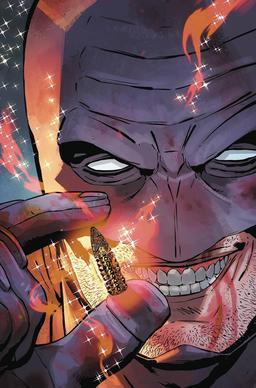
Midnighter is a fictional superhero appearing in American comic books first published by WildStorm and later DC Comics once it absorbed the former. The character was created by writer Warren Ellis and artist Bryan Hitch. The character made his first appearance in Stormwatch #4, titled "A Finer World ". He went on to appear in various Authority books and other series, as well as his own eponymous ongoing series.

The Tasmanian Devil is a fictional superhero appearing in DC Comics, depicted as a gay pacifistic Australian metahuman with the ability to turn into a giant aggressive Tasmanian devil. He first appeared in Super Friends #7, with his first post-Crisis appearance being in Infinity, Inc. #32.
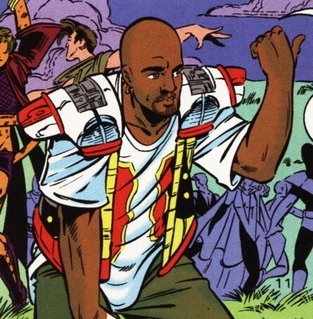
Hero Cruz is a fictional character in comic books published by DC Comics. Within the narrative of the fictional DC Universe, Hero is a portrayal of a Latino gay superhero of African descent. He first appeared in Superboy and the Ravers and was created by Karl Kesel and Steve Mattsson.
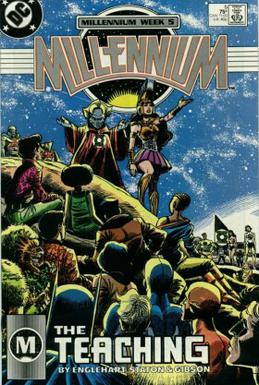
"Millennium" was a comic book crossover story line that ran through an eight-issue, self-titled, limited series and various other titles cover dated January and February 1988 by DC Comics. The limited series was published weekly, which was a departure for an American series. It was written by Steve Englehart, and with art by Joe Staton and Ian Gibson.

The New Guardians are a DC Comics superhero team featured in the short-lived eponymous series The New Guardians. It was a spin-off from the Millennium event and ran for twelve issues, from 1988 through 1989, before being canceled. The characters first appeared in Millennium #1,, written by Steve Engelhart and drawn by Joe Staton. The series has since gained infamy among comic fans due to its poor writing and second issue, which features "Snowflame", a supervillain who gained powers from the use of cocaine.

In comics, LGBT themes are a relatively new concept, as lesbian, gay, bisexual, and transgender (LGBTQ) themes and characters were historically omitted from the content of comic books and their comic strip predecessors due to anti-gay censorship. LGBT existence was included only via innuendo, subtext and inference. However the practice of hiding LGBT characters in the early part of the twentieth century evolved into open inclusion in the late twentieth and early twenty-first centuries, and comics explored the challenges of coming-out, societal discrimination, and personal and romantic relationships between gay characters.
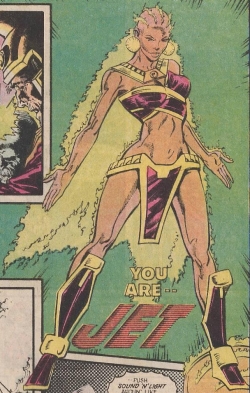
Jet is a fictional superhero published by DC Comics. She first appeared in Millennium #2 and was created by Steve Engelhart and Joe Staton.

Betty Clawman is a fictional superhero and disembodied cosmic force in the DC Comics shared universe. She first appeared in Millennium #2, and was created by Steve Englehart and Joe Staton.
In American mainstream comics, LGBT themes and characters were historically omitted intentionally from the content of comic books, due to either formal censorship or the perception that comics were for children and thus LGBT themes were somehow inappropriate. With any mention of homosexuality in mainstream United States comics forbidden by the Comics Code Authority (CCA) until 1989, earlier attempts at exploring these issues in the US took the form of subtle hints or subtext regarding a character's sexual orientation. LGBT themes were tackled earlier in underground comix from the early 1970s onward. Independently published one-off comic books and series, often produced by gay creators and featuring autobiographical storylines, tackled political issues of interest to LGBT readers.

Gay interpretations have been part of the academic study of the Batman franchise at least since psychiatrist Fredric Wertham asserted in his 1954 book Seduction of the Innocent that "Batman stories are psychologically homosexual". Wertham, as well as parodies, fans, and other independent parties, have described Batman and his sidekick Robin as homosexual, possibly in a relationship with each other. Several characters in the Modern Age Batman comic books are expressly gay, lesbian, or bisexual.

Superhero comics is one of the most common genres of American comic books. The genre rose to prominence in the 1930s and became extremely popular in the 1940s and has remained the dominant form of comic book in North America since the 1960s. Superhero comics feature stories about superheroes and the universes these characters inhabit.

Midnighter and Apollo is a six-issue American comic book limited series published by DC Comics. It is written by Steve Orlando and illustrated by Fernando Blanco, with covers by ACO. The series debuted in October 2016 and finished in March 2017. The story takes some time after the end of Midnighter, with Midnighter and Apollo having reunited. Following a battle with demons, Apollo's soul is dragged to Hell, and Midnighter attempts to bring him back.
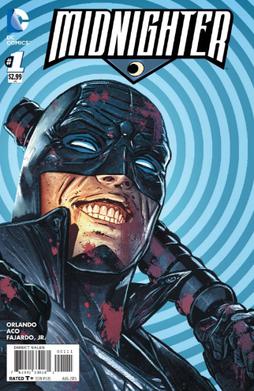
Midnighter is an American comic book series published by DC Comics and written by Steve Orlando that ran for twelve issues from June 2015 to July 2016, featuring Midnighter as its protagonist. The series is also known as Midnighter to differentiate itself from the character's previous series first published by WildStorm in 2006.

Steve Orlando is an American comic book writer, known for his work for DC Comics writing characters such as Batman, Martian Manhunter, and Wonder Woman, and two series starring Midnighter, which were nominated for a GLAAD Media Award.

Justice League Queer, or JLQ, is a fictional superhero team appearing in American comic books published by DC Comics. Justice League Queer was an ad-hoc team of LGBTQIA+ heroes formed by Gregorio de la Vega to fight off Eclipso when he attacked a pride parade. The team is a variation on one of DC's long-running properties, the Justice League. The JLQ was originated by Andrew Wheeler and Luciano Vecchio.

DC Pride is an annual LGBTQIA+-themed comic book anthology first published by DC Comics in June 2021. The second anthology was published in June 2022. The third anthology was released in May 2023.

















